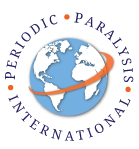What is Andersen-Tawil Syndrome?
Andersen-Tawil Syndrome (ATS) is a rare inherited disorder which causes episodes of paralysis or weakness, heart rhythm irregularities including a prolonged QT interval which makes the heart more likely to experience tachycardia (a regular but too rapid heart rate) or dangerous irregular heart rates. ATS typically causes some physical characteristics as well. These include large, widely spaced eyes, a small jaw, low-set ears, crooked fingers or toes, webbed or fused 2nd and 3rd toes, a curvature of the spine and small stature. ATS is very rare and has been diagnosed in only a few hundred families in the world. It was only recognized as a separate disorder in 1971.
What causes ATS?
Ion channels are tiny pores (openings) that allow ions (molecules) of sodium and potassium to move through the cell membrane. This movement of sodium and potassium ions from one side of the muscle membrane to the other creates an electrical current. For the muscles to work properly sodium and potassium ions must be kept in the correct ratio inside and outside the cell.
ATS is caused by genetic mutations which cause a malfunction in certain potassium channels in the body. These ion channels fail to regulate the flow of ions properly when potassium levels in the blood change. The ratio of sodium and potassium inside and outside the cell become unbalanced. The muscles respond less when asked to move, which is felt as weakness. If the imbalance becomes pronounced the muscles quit responding at all, i.e. is paralyzed. Ion channels in the heart muscle are also affected, which leads to certain patterns of irregular heart rhythms. These unusual heart rhythms can be seen on an electrocardiogram.
Will I pass ATS on to my children?
ATS is inherited in an autosomal dominant pattern. The chances that a child of an affected person will inherit the defective gene is ‘statistically’ 50%, but not all who inherit the gene will have symptoms. The degree to which children are affected may vary from one child to the next. One child may be mildly affected, the next seriously affected and the next completely unaffected.
What triggers attacks?
Triggers may vary from person to person. For example food triggers for ATS are not as easily recognized as they are in other types of periodic paralysis, where it is possible to say potassium-rich foods or carbohydrate-rich foods trigger episodes. Since the patient’s potassium level may vary from episode to episode it may take real attention to one’s body’s signals to recognize food triggers. In some ATS patients food does not seem to be a trigger at all.
Common triggers are rest after activity and periods of inactivity (for example; sitting through a long class or church service, especially in a cool room). Sleep is a potent trigger. Going too long without eating is another trigger, as is eating a large meal. Getting chilled is a trigger. Emotional events may trigger attacks. Gasoline or paint fumes and car exhaust have been reported as triggers by some patients, and are probably best avoided when possible.
How is ATS treated?
Since individuals vary so much it is impossible to give guidelines which apply to all ATS patients. Medications which regulate the heart are often prescribed, other treatment depends on the individual and their reaction to potassium. Patients with severe heart rhythm problems may require a pacemaker-like device.
What tests are used to diagnose ATS?
A variety of tests may be used. The presence of paralytic attacks accompanied by heart arrhythmias which include a prolonged QT interval are strongly suggestive of ATS and should be evaluated by a thoroughly experienced team of physicians. The subject of diagnosis is one which is somewhat complex, and is outside the scope of this discussion. For more information see The Exercise EMG and Physician’s Sheet: Andersen-Tawil Syndrome.
Can I have a DNA test for ATS?
Genetic testing is now available for ATS. The genetic variants responsible for ATS have so far been found in two potassium genes; KCNJ2 and KCNJ5.
Will I be able to lead a normal life?
Most people with ATS lead reasonably normal lives. Many cases are mild, and even patients who are more severely affected can manage their symptoms through medication and attention to diet and lifestyle issues. There is no cure, but most patients lead well-rounded and fulfilling lives. There is no denying that some patients have physically- compromised lives, especially patients with a long history of frequent and severe episodes. But many patients are able to remain quite active.
Will I end up in a wheelchair?
This is a hard question to answer. Permanent muscle weakness is a fact of life for many older patients with periodic paralysis, and activities like climbing stairs and walking long distances may become very fatiguing. Some of our older members use a wheelchair or ‘scooter’ outside the home, but are mobile and on their feet inside the house. Very few rely on a wheelchair full-time unless their condition is complicated by other problems. From our experience most patients with ATS have fewer symptoms as they age.
Will my life be cut short by ATS?
Diagnosis and treatment are vital to ATS patients. The primary danger in ATS is from heart arrhythmias, which are distressing but not often fatal. These are treatable.
